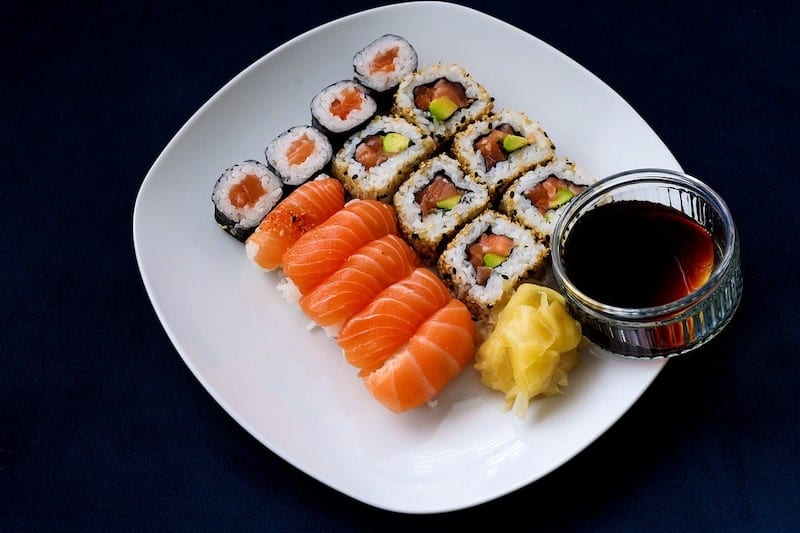Why Is Ginger Served with Sushi?
If you’ve eaten sushi in a restaurant, you might have noticed that it’s often served with ginger.
Specifically, a kind of pink ginger called Gari. However, it’s not uncommon to see the more typical beige, yellow ginger.
But why is ginger served with sushi? Nowadays, it’s primarily used for aesthetic purposes.
In the past, it was used to preserve raw fish from contamination. It’s also believed that you should take it before or after sushi as a palate cleanser.
Keep on reading to learn more about the custom of serving ginger with sushi.
Why Do You Eat Ginger with Sushi?
Aesthetics play an essential role in sushi culture, and ginger is no exception.
Traditionally, this ginger is pickled to attain a pink color. Gari, or pickled ginger, is a Japanese delicacy made by preserving young, pinkish slices of ginger.
Vinegar and sugar maintain the pink tint of pickled veggies, making them more prominent. Gari is frequently referred to as “pink ginger” for this reason.
It’s all about this one component for traditional sushi presentation. The pink ginger adds to the overall appearance of the dish.
Typically, ginger is eaten as a palate cleanser before or after the meal. Although first used to fight off hazardous germs on raw foods, it has evolved into a more versatile tool.
Do You Have to Eat Ginger with Sushi?
Technically, you don’t need to have ginger with your sushi.
However, as mentioned, the purpose of ginger is to cleanse and refresh the palate between sushi courses. This means that a chef will add ginger to balance out the flavors in the dish.
If you decide to eat ginger, don’t put it on the sushi roll.
Instead, pop a slice of ginger into your mouth between bites of sushi to neutralize the flavor before trying a different piece.
Substitutes for Ginger When Eating Sushi
If you decide that ginger isn’t the right fit for you, there are some substitutes that you can try.
Pickled Plums
The vinegar made from umeboshi or pickled plums is crucial in red pickled ginger’s taste. So instead of pink gari, why not use them instead?
Pickled plums come in various flavors, including honey-pickled plums, which are rather sweet.
Plums pickled with shiso leaves are a good choice if you prefer salty rather than sweet food. Note that it has a flavor similar to red shiso pickled ginger.
Thanks to the plum’s crimson hue, it can be used to brighten up any dish.
Pickled plums with a sweet flavor work just as well if you can’t master the salty variety.
Shibazuke
Kyoto-style pickled vegetables salted with shiso leaves are known as shibazuke.
Cucumber is the most common ingredient, although eggplant may also be used.
Compared to gari, the red hue of shibazuke makes it an excellent replacement for red shiso.
Shibazuke has a crisp texture and is another excellent substitute. Despite its origins in Kyoto, this dish is enjoyed by people worldwide.
Kimchi
This type of pickle is made mainly of cabbage, salt, pepper, and various other herbs and spices.
The somewhat spicy flavor of kimchi sets it apart from other condiments. Unlike red pickled ginger, which has a strong flavor, this condiment is made from red peppers.
To make up for the lack of spiciness, you may use kimchi, which has a lot of umami (savory flavor) and koku (spiciness). As a result, it’ll be a great addition to various recipes.
Homemade Red Pickled Ginger
If you already have plum vinegar in your pantry, you can use it to make your own gari at home.
You only need to soak the young ginger in the plum vinegar overnight and shred it. Since the vinegar can be very salty, you can add sugar to reduce the saltiness.
In this way, you can adapt the taste of the ginger to your liking and substitute the ginger served in restaurants.
Alternatively, you can even attempt to make your own sushi rolls!
In Summary
The answer to the why ginger is served with sushi is simple – to make the sushi more visually appealing and to cleanse the palate between different bites.
This means that you don’t have to eat ginger if you really don’t like it. Or, you can use any of the suggested substitutes instead!
For example, if you want to cleanse your palate between sushi rolls but don’t want to eat ginger, wasabi can help. Whatever you decide, you’ll still be able to enjoy your meal to the full.







